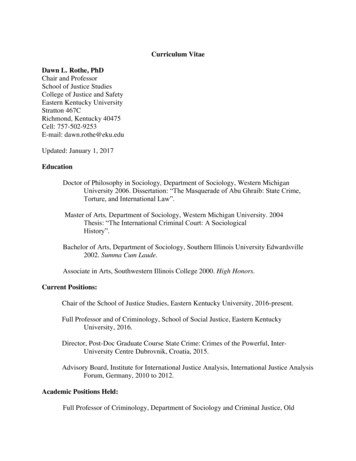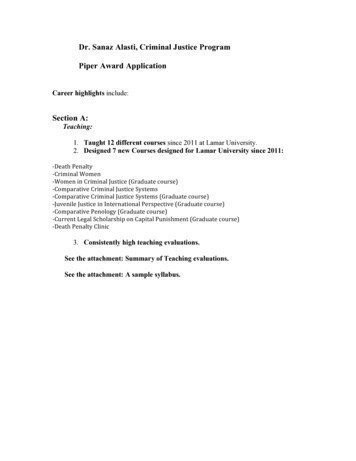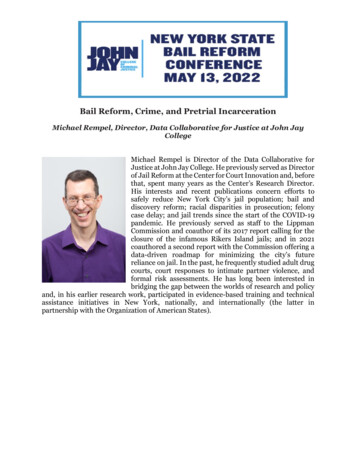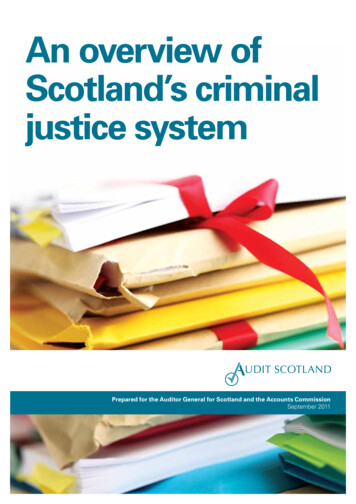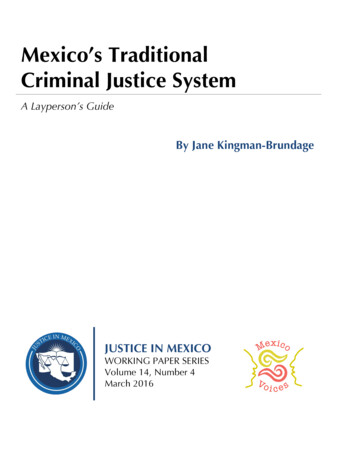
Transcription
Navigatingthe criminaljustice systemA guide for voluntary organisationsworking in the criminal justice systemin England and WalesJanuary 2022
Navigatingthe criminaljustice systemIn this mentsandagenciesThe policeThe courtsand outof courtdisposals4568A guide for voluntary organisationsworking in the criminal justice systemin England and WalesThis guide is aimed at people working or volunteering forvoluntary organisations that support people in the criminaljustice system. The criminal justice system in England andWales can be daunting to understand because of both its sizeand complexity. This guide aims to help you understand howthe criminal justice system is organised and how it works.The criminal justice system comprises of governmentdepartments and several agencies.2 Clinks / Navigating the criminal justice andregulatorsLocal andregionalstructuresChildrenin thecriminaljusticesystem171921
An overview of the criminal justice systemCentral governmentMinistryof ateof Policing& CrimePolice & JusticeBoardPublic &private calgovernmentHerMajesty’sPrison yHerMajesty’sCourts ffenderInstitutionsLocal partnerships between multiple agencies, including voluntary organisationsIntegrated Offender Management3 Clinks / Navigating the criminal justice systemLocal Criminal Justice BoardsCrown CourtsLocally developed networks
About the voluntary sectorVoluntary organisations working in the criminal justice system have a longhistory of providing services that complement and supplement statutory criminaljustice services. Throughout its rich history, the voluntary sector has used itsknowledge and expertise as a driver for positive change. From early steps toreform prison conditions in the 1800s, to more recent developments pioneeringdistinct services for women in the criminal justice system, developing supportservices for families of prisoners and championing service user led approaches.The voluntary sector working in criminal justice covers a wide spectrum– from small, volunteer-run community groups to large nationalorganisations which employ hundreds of people. Many employ a mix ofpaid and voluntary staff. Thousands of voluntary sector organisationsdon’t specifically target people with convictions but include themwithin their client group because of the nature of their work.Voluntary organisations often provide wrap-around servicesto enable and support individuals to undertake and completetheir sentence and go on to live fulfilling lives.4 Clinks / Navigating the criminal justice systemThe voluntary sector is particularly well known for providing specialistservices that reflect the diversity and needs of individuals. There aremany specialist organisations for groups such as veterans, foreignnationals, mothers and babies in prison; and networks that linkcommon services, e.g. around the arts, faith and sport. The voluntarysector remains a key provider of support for families of prisoners.Information on hundreds of voluntary sector organisations providingservices to people affected by the criminal justice system and theirfamilies can be found on Clinks’ Directory of Services. Voluntary sectororganisations can register their details on the directory for free.
Ministry of JusticeThe Ministry of Justice is responsible for courts, prisons, probation services andattendance centres.* It oversees the work of Her Majesty’s Courts and TribunalsService (HMCTS) and Her Majesty’s Prison and Probation Service (HMPPS).Home OfficeThe Home Office is the lead government department for the43 police forces, providing national support for the work oflocally elected Police and Crime Commissioners (PCCs).Her Majesty’s Courts and Tribunals ServiceHer Majesty’s Courts and Tribunals Service was created in April 2011. It isresponsible for the administration of criminal, civil and family courts and tribunals.Nationalgovernmentdepartmentsand agenciesHer Majesty’s Prison and Probation ServiceHer Majesty’s Prison and Probation Service is an executive agency of theMinistry of Justice. Created in April 2017, HMPPS is responsible for managing theoperations, performance and commissioning of prison and probation services,rehabilitation services for people leaving prison, and making sure support isavailable to help people stop reoffending. Through Her Majesty’s Prison Service,HMPPS manages public sector prisons and youth custody and the contracts forprivate prisons. Through the Probation Service, it oversees probation delivery.* Young people are sometimes required to attend attendance centres as part of a community sentence or court order5 Clinks / Navigating the criminal justice system
There are 43 police forces. The police are responsible for keepingthe peace and investigating offences reported to them.They provide information and advice to the Crown Prosecution Service(CPS) about alleged offences committed by individuals. Their role is touphold the law, to prevent crime, to pursue and bring to justice thosewho break the law, and to protect and reassure the community.The police are the first point of contact for people entering the criminaljustice system. They are also a potential point of diversion away fromit. Police forces work with a range of local community organisationsto reduce criminal or antisocial behaviour and activity. You can findlinks to your local police force by visiting the police.uk website.The police6 Clinks / Navigating the criminal justice systemLiaison and Diversion servicesLiaison and Diversion services identify individuals who have a learningdisability, mental health or substance misuse issue, or other vulnerabilities,when they first come into contact with the criminal justice system. Criminaljustice agencies are trained to recognise possible signs of vulnerability inpeople when they first meet them (when they come into contact with thepolice or the courts) and involve their local Liaison and Diversion service toengage with the person for further assessment of their needs. The servicecan then support people, refer them for appropriate health or social careor enable them to be diverted away from the criminal justice system into amore appropriate setting, including support by voluntary organisations.
Police and Crime CommissionersThe first Police and Crime Commissioners (PCCs) were introduced inNovember 2012 and replaced what were previously Police Authorities.There are PCCs in 40 police forces. In Greater Manchester, WestYorkshire and London, PCC responsibilities sit with the Deputy Mayor.The PCC is an elected official and is answerable to the public.The core functions of PCCs are to secure the maintenance of an efficientand effective police force within their area, and to hold the ChiefConstable to account. They each have oversight of a police and crimeplan which seeks to reduce crime and improve community safety intheir geographical area. PCCs are responsible for the police fund (fromwhich all policing of the area is financed). More information regardingPCCs in your area and police and crime plans can be found here.Association of Police and Crime CommissionersThe Association of Police and Crime Commissioners (APCC) is the nationalmembership body that supports Police and Crime Commissioners,Police, Fire and Crime Commissioners (PFCCs), Deputy Mayors and otherlocal policing bodies to provide national leadership and drive strategicchange across policing, criminal justice and wider community safety.7 Clinks / Navigating the criminal justice system
Almost all criminal cases begin with an offence being reported to the police.If there are reasonable grounds to suspect a crime has been committed,the police will arrest an individual and, following an investigation, if thereis enough evidence, they may recommend to the Crown ProsecutionService that the individual is charged with a specific offence.Out of court disposalsOut of court disposals (OOCD) are a range of options available to the police touse in certain cases as an alternative to a prosecution. They allow the police todeal quickly with low-level offending without recourse to the courts and arean opportunity to provide intervention and support to individuals, divertingthem into rehabilitative services to help reduce escalation of offending.The courts and outof court disposals8 Clinks / Navigating the criminal justice systemBail and remandThe first court hearing after an individual is charged is at a magistrates’court. After being charged, the individual may be released on bail. Thismeans they are released until their court hearing, but they might have toagree to certain conditions, for example living at a particular address andnot contacting certain people. If bail is refused by the courts, the personwill be remanded in custody until their court hearing. When a person isremanded in custody it means that they will be kept in prison until a laterdate when a trial or sentencing hearing will take place. Further informationregarding bail conditions and reasons for bail refusal can be found here.
Magistrates’ and crown courtsWhen an individual is charged with a specific offence, this means the casewill be going to court. The criminal courts are divided into magistrates’ courtsand crown courts. All cases start in a magistrates’ courts. There are someoffences that are less serious and can only be dealt with at this level (includingmost motoring offences and minor criminal damage – these are known as‘summary offences’). There are other offences which can be heard at eitherthe magistrates’ or crown courts (such as burglary and drugs offences – theseare called ‘either way’ offences). More serious offences are dealt with by crowncourts (such as murder and rape – these are known as ‘indictable offences’).Magistrates are volunteers who have been trained and have the support andadvice of legally qualified court clerks. Judges sit primarily in the crown courtand are qualified barristers who have been appointed to the judiciary.If an individual is charged with a minor offence, the case could be decided by amagistrate without the person going to court (known as a ‘single justice procedure’).If a person gets a single justice procedure notice they must respond within 21 days.Problem solving courtsProblem solving courts generally operate out of existing courts.They use the authority of the court combined with the other servicesnecessary to provide treatment, reduce re-offending and improveoutcomes. They usually have a particular specialism, for example aspecific need such as drug abuse, a specific crime, such as domesticabuse, or a specific group of people such as women or young adults.9 Clinks / Navigating the criminal justice system
If the individual pleads guilty, or is found guilty after atrial, the magistrate or judge imposes a sentence.Depending on the seriousness of the offence, the Probation Service mightbe asked to prepare a pre-sentence report on the individual and theinformation, assessments, and recommendations in the report will be usedto help the magistrate or judge arrive at a decision. There are many types ofsentence that a judge or magistrate can give. They range from dischargesand fines, which are given for lower-level offences, up to life sentencesin prison for the most serious crimes. The Sentencing Council has moredetail on the range of sentences, but these are summarised below.DischargesDischarges are where a person is released from court without any further action.These are given for the least serious offences. There are two types of discharge: An ‘absolute discharge’ means that no further action will be taken A ‘conditional discharge’ means that no further action will be taken as long asthe person does not commit another offence during the discharge period.Sentences10 Clinks / Navigating the criminal justice systemFinesFines are the most common type of sentence given by the courts. They areusually given for lower-level offences and must be paid within a set period of time.
Community sentencesCommunity sentences are overseen by the Probation Service and combinesome form of punishment with activities carried out in the community.There are 13 possible requirements that a person given a communitysentence might be expected to meet and they can be given just one ora combination. Community sentence treatment requirements (CSTRs)are a requirement for a person to complete treatment for a mentalhealth, drug and/or alcohol problem as an alternative to custody.Suspended prison sentencesSuspended prison sentences are prison sentences of between 14 days andtwo years (or six months in the magistrates’ court) which are suspended for upto two years. This means that the person does not go to prison immediatelybut must carry out their sentence in the community by complying with up to13 requirements set by the court (as for community sentences, above). If theperson does not adhere to the requirements set by the court, they can then besent to prison to serve the remainder of the original length of sentence given.Prison sentencesPrison sentences are reserved for the most serious offences and may beimposed where the court believes it is necessary to protect the public.The type and length of sentence depends on the seriousness of theoffence and the maximum penalty for the crime allowed by law.11 Clinks / Navigating the criminal justice systemDeterminate prison sentences are prison sentences with a fixed length. This isthe most common type of prison sentence. For prison sentences of 12 monthsor more, the person spends the first half of the sentence in prison and thesecond half in the community ‘on licence’, which will include specific conditions.Whilst on licence the person will be subject to a period of supervision andif the conditions of their licence are not met or are ‘breached’ they may berecalled to prison. For prison sentences under 12 months, the person is normallyreleased automatically halfway through, followed by a period of supervision.People serving sentences of between three months and four years, with certainexceptions for violent or sexual offences, may also be eligible for release on ahome detention curfew (HDC). This allows a person to be released up to 135 daysbefore their automatic release date. They will be electronically tagged, and acurfew imposed. If a person breaches the curfew they can be recalled to prison.Indeterminate prison sentences of Imprisonment for Public Protection (knownas IPP sentences) do not have a fixed length of time. This means no releasedate is set and the person must spend a minimum amount of time in prison(called a ‘tariff’) before they are considered for release. The Parole Board isresponsible for deciding if someone can be released from prison. This wasintended to apply to people convicted of serious offences who did not merita life sentence and was abolished in 2012. However, the abolishment of thesesentences was not retrospective and there are still people in prison serving anIPP sentence who are well over their minimum tariff but have yet to be released.
Life sentencesLife sentences last for the rest of a person’s life. This sentence can mean theperson spends time both in prison and in the community subject to licenceconditions. If they are released from prison and commit another crime, theycan be sent back to prison at any time. If a person is found guilty of murder,a court must give them a life sentence. When passing a life sentence, a judgemust specify the minimum term (called the ‘tariff’) they must spend in prisonbefore becoming eligible to apply to the Parole Board for release. The onlyexception to this is when a life sentence is passed with a ‘whole life order’meaning that the person will spend the rest of their life in prison, until death.12 Clinks / Navigating the criminal justice system
HM Prison Service is a part of HMPPS, and comprises over 120 prisons.Some of these are contracted out to private companies. Mostprisons are for adult males. There are ten for women and fiveare young offender institutions holding young men aged 15to 21. You can search the current list of prisons here.Prison regimes include opportunities for training, education, drug treatment,and include advice and practical support to prepare people for release andsupport with issues like accommodation, employment and finance. Adult prisonsare broadly categorised according to the level of security each provides.Category A prisonsCategory A prisons (the High Security Estate) hold individuals who areconsidered to be the most dangerous, serving long sentences for seriousoffences. Category A prisoners are those that would pose the most threat tothe public, criminal justice agencies, or national security should they escape.Prisons13 Clinks / Navigating the criminal justice systemCategory B prisonsCategory B prisons hold individuals serving long to medium length sentences whoare deemed less of a risk (in comparison to Category A) to the public, criminal justiceagencies, or national security. They often present a lower risk of potential escape.Some Category B prisons partly or wholly function as remand prisons, holding peoplein pre-trial detention. A considerable proportion of the people in remand prisonsmay be there for a short period of time. Category B prisons that contain remandedprisoners are sometimes also known as ‘local prisons.’ People serving sentencesof less than 12 months often remain in their ‘local prison’ until they are released.
Category C and D prisonsCategory C (training) prisons and Category D (open) prisons holdindividuals who are less of a risk to the public and present a much lowerrisk of escape. These prisons are often more focused on resettlement,with most people in these prisons approaching the end of their sentenceand preparing for release back into the community. This will include theopportunity for prisoners to leave prison under release on temporarylicence (ROTL), which allows them to undertake voluntary work placements,paid employment or can allow for overnight visits to relatives.Women’s estateThere are currently 10 women-only prisons with six having mother and babyunits, plus one women’s custodial unit on the HMP Peterborough site where adultmen are also held in separate facilities. Clinks continues to represent and providesupport to organisations working with women in the criminal justice system.CategorisationFollowing initial categorisation, subsequent reviews will take place andconsideration given to whether there has been a change in the risks presentedby the individual since their last review. As a result of this assessment adecision is made as to the most appropriate conditions for that person.This can include a decrease or increase in security categorisation.14 Clinks / Navigating the criminal justice systemYou can find out the number of people in prison on the HowardLeague for Penal Reform website, along with other statistics relatedto prisons and the criminal justice system in the latest BromleyBriefing prisons factfile, published by the Prison Reform Trust.
The Probation Service is the statutory criminal justice service thatsupervises people in the community who have been released fromcustody on license and people who have received community sentences.The Probation Service is responsible for: Advising courts on sentencing decisions, includingpreparation of pre-sentence reports Working with people in custody to prepare them for life after releasethrough the Offender Management in Custody (OMiC) model Monitoring the risk posed by people supervised in thecommunity and ensuring the public is protected Planning and delivering rehabilitative support, often inpartnership with voluntary sector organisations Enforcing compliance with court orders and licence conditions, includingprovision of accredited programmes and unpaid work placements.Probation15 Clinks / Navigating the criminal justice systemThe Probation Service is made up of 12 probation areas – 11 regionalprobation areas across England and a probation service area for Wales.Each area is overseen by a Regional Probation Director (RPD) who isresponsible for the overall delivery and commissioning of probationservices in their area. RPDs hold responsibility for delivery of sentencemanagement, unpaid work, and interventions. They hold significantregional commissioning budgets for rehabilitative services.
Voluntary sector and private sector organisations are commissioned to deliverrehabilitation and resettlement services through the national probation DynamicFramework in 11 of the probation areas. Greater Manchester Probation Serviceco-commissions services with Greater Manchester Combined Authority (GMCA)through the Integrated Rehabilitative Service (IRS) procurement system.Each of the 12 probation areas has published a Regional Reducing ReoffendingPlan which sets out how they will work with partner organisations to addressthe causes of reoffending. The plans, which are renewed annually, allowRPDs to highlight specific priorities and ambitions for their individual areas.Clinks continues to engage with the MoJ, HMPPS and Regional ProbationDirectors to ensure the voluntary sector is a central partner to theProbation Service. Further information on our work can be found here.16 Clinks / Navigating the criminal justice system
Independent inspectorates and regulators exist forthe following criminal justice agencies.Her Majesty’s Inspectorate of Constabulary and Fire & Rescue ServicesHer Majesty’s Inspectorate of Constabulary and Fire & Rescue Services (HMIC)independently assesses police forces and policing and publishes informationto allow the public to compare the performance of their force against others.Independent Office for Police ConductThe Independent Office for Police Conduct (IOPC) oversees the policecomplaints system. It investigates the most serious matters and sets thestandards by which police should handle complaints, using learning fromits work to influence changes in policing. It is independent and makesdecisions entirely independently of the police and the government.Her Majesty’s Crown Prosecution Service InspectorateHer Majesty’s Crown Prosecution Service Inspectorate (HMCPSI)inspects the Crown Prosecution Service and the Serious Fraud Office,providing independently assessed evidence to help drive improvementand build public confidence in the prosecution process.Inspectoratesand regulators17 Clinks / Navigating the criminal justice systemHer Majesty’s Inspectorate of Prisons for England and WalesHer Majesty’s Inspectorate of Prisons for England and Wales (HMI Prisons)is an independent inspectorate, led by HM Chief Inspector of Prisons,which reports on conditions for and treatment of those in prison, youngoffender institutions, secure training centres, immigration detention
facilities, police and court custody suites, customs custody facilities andmilitary detention. In 2017 the Urgent Notifications process was introducedso that HM Chief Inspector of Prisons can alert the Secretary of State forJustice where there are urgent and significant concerns about a prison.Her Majesty’s Inspectorate of ProbationHer Majesty’s Inspectorate of Probation (HMI Probation) is the independentinspector of probation and youth offending services. As well as inspections ofindividual/regional services, it publishes regular thematic reports on key issues inthe criminal justice system and conducts Serious Further Offence (SFO) reviews.Independent Monitoring BoardsIndependent Monitoring Boards (IMBs) are made up of members that areindependent, unpaid and conduct an average of 2-3 visits per month. Theyhave unrestricted access to their local prison or immigration detention centreand can talk to any prisoner or detainee they wish to, out of sight and hearingof members of staff if necessary. Their role is to monitor day-to-day life inthese settings and ensure that proper standards of care and decency aremaintained. They also play a significant role in dealing with individual issues.Prisons and Probation OmbudsmanThe Prisons and Probation Ombudsman (PPO) carries out independentinvestigations into complaints and deaths in custody. It investigates complaintsmade by prisoners, young people in detention (prisons and secure trainingcentres), people under probation supervision and individuals detained underimmigration powers (detained individuals). It investigates deaths of prisoners,18 Clinks / Navigating the criminal justice systemyoung people in detention, approved premises residents and detained individualsdue to any cause, including any apparent suicides and natural causes. It alsoinvestigates deaths of recently released prisoners, using its discretionary powers.
Local Criminal Justice BoardsLocal Criminal Justice Boards (LCJBs) are locally created forumswithin which partnerships of local criminal justice agencies cancollaborate. They operate as a voluntary partnership in mostcounties in England, usually around a police force area.They are often chaired by the local Police and Crime Commissioner or ChiefConstable. They typically include representatives from the police, Officeof the PCC, Crown Prosecution Service, HM Courts and Tribunal Service,HM Prison Service, Probation Service, and the youth offending team.Community Safety PartnershipsCommunity Safety Partnerships (CSPs) are hosted by the local authorityand, working closely with the PCC, it is their responsibility to bring togetherkey criminal justice partners to discuss and inform ways in which crimecan be reduced at a local level. CSPs hold a small amount of funding forlocal initiatives and can be an effective mechanism for voluntary sectororganisations to push for local action to address issues of crime and justice.Local and regionalstructures19 Clinks / Navigating the criminal justice systemReducing Reoffending BoardsReducing Reoffending Boards are generally convened by the Police andCrime Commissioner, or the Deputy Mayor with PCC responsibility indevolved areas. Their aim is to bring together local partners and seniorleaders from statutory and voluntary sector agencies to develop strategies,activities and funding opportunities based on local priorities and need, toprevent and reduce reoffending in communities. In some regions, these
boards have representation from all the PCCs within a region, prison andprobation leads and wider sector agencies – for example NHS and localauthorities. These allow a range of partners to develop effective strategiesacross whole regions. These can enable co-commissioning opportunitiesfor organisations working with individuals in the criminal justice system.Integrated Offender ManagementIntegrated Offender Management (IOM) brings together the police, probation andother agencies, including the voluntary sector, to develop and deliver a local andcollective response to persistent and problematic offending. It aims to reduce thenegative impact of crime and reoffending by working in partnership to identifyand manage individuals who have committed prolific and repeat offences inlocal communities, providing and directing them to relevant support services.Further details can be found in the Integrated Offender Management strategy.20 Clinks / Navigating the criminal justice system
The Youth Justice Board (YJB) is an executive non-departmentalpublic body, sponsored by the Ministry of Justice, that overseesthe youth justice system (for people under the age of 18).YJB members are appointed by the Secretary of State for Justice. Their mainfunction is to monitor the operation of the youth justice system and theprovision of youth justice services. The YJB provides guidance, support andinformation for practitioners in Youth Offending Teams and others workingwith young people in, or at risk of contact with, the criminal justice system.Youth offending teams work with children aged 10-18 who have come intocontact with the criminal justice system. There is a youth offending team inevery local authority. Find your local youth offending team here. The youthoffending team gets involved if a child has come to the attention of thepolice because of their behaviour or is arrested and is charged with a crimeand has to go to court, or is convicted of a crime and given a sentence.Children inthe criminaljustice system21 Clinks / Navigating the criminal justice systemThe Youth Custody Service is a distinct part of HMPPS, established in 2017,responsible for the running of public sector sites across the youth secureestate. The youth secure estate is made up of five under-18 Young OffenderInstitutions, two Secure Training Centres and eight Secure Children’s Homes.Young Offender InstitutionsYoung Offender Institutions (YOIs) are for people aged 15-21. Peopleaged 15-17 are held separately to people aged 18-21. Some YOIs arestandalone institutions, but in some instances are co-located.
Secure Training CentresThere are currently three Secure Training Centres (STCs), two of which are runby private contractors while a third is managed by HM Prison Service. The YouthJustice Board purchases places for children. STCs hold children aged 12-17.Secure Children’s HomesSecure Children’s Homes (SCHs) are all run by local authorities.The Youth Justice Board can purchase places for boys andgirls aged 10-14. SCHs range in size from 8 to 40 beds.Navigating the criminal justicesystem – information sessionsAre you new to working or volunteering in the criminal justicesystem? Do you have volunteers or staff members who want toincrease their understanding of the criminal justice system?We hold information ses
the criminal justice system is organised and how it works. The criminal justice system comprises of government departments and several agencies. National government departments and agencies 5 The police 6 The courts and out of court disposals 8 Sentences 10 Prisons 13 Probation 15 Inspectorates and regulators 17 Local and regional structures 19 Children in the criminal justice system 21 In .




